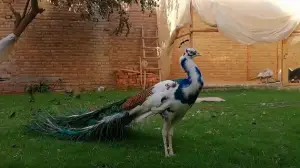
Peacocks are known for their stunning appearance and captivating displays. With their vibrant feathers and graceful movements, they have become iconic symbols of beauty and elegance.
But have you ever wondered if peacocks actually have wings? In this article, we will explore the fascinating world of peafowl and shed light on the question of whether peacocks possess wings.
Understanding Peafowl Anatomy
To determine whether peacocks have wings, we must first understand their anatomy. Peafowl, which include both male (peacock) and female (peahen) birds, belong to the pheasant family. They have long, slender bodies and relatively short legs. Like all birds, peafowl possess wings, but their functionality differs from what we typically associate with wings.
The Function of Peacock Feathers
Peacock feathers are renowned for their iridescent colors and intricate patterns. These feathers serve multiple purposes, including attracting mates and deterring predators. However, it is important to note that the extravagant feathers we often associate with peacocks are not their actual wings.
The Mystery of Peacock Wings
Peacock wings, or more accurately, primary flight feathers, are located underneath the showy plumage. These wings are smaller and less noticeable compared to the long, flowing train of feathers. While they are not used for flying, they play a crucial role in maintaining balance and providing stability during the peacock’s courtship displays.
The Role of Wings in Flight
Unlike many other bird species, peafowl are not proficient flyers. Their wings are not designed for sustained flight, and they rely primarily on their leg muscles for movement. Peafowl can, however, make short, low flights to escape from predators or reach higher roosting spots.
Peafowl: A Grounded Bird
Peafowl spend the majority of their time on the ground, foraging for food and socializing within their groups called “parties” or “prides.” Their legs are strong and adapted for terrestrial locomotion. While they may not soar through the skies like other bird species, their remarkable wings still serve a purpose in their daily lives.
The Elaborate Courtship Displays
One of the most awe-inspiring sights associated with peacocks is their elaborate courtship displays. During these displays, the male peacock spreads his magnificent train of feathers, creating a fan-like shape. The wings, tucked underneath the train, remain hidden from view but play a crucial role in maintaining balance and supporting the weight of the display.
The Importance of Plumage
The elaborate plumage of peacocks serves as a visual signal to attract peahens during courtship rituals. The vibrant colors and intricate patterns indicate the overall health and genetic fitness of the male. While the train steals the spotlight, the wings contribute to the overall visual display, enhancing the peacock’s attractiveness.
The Peacock’s Tail
The peacock’s tail is an extension of its back feathers rather than its wings. This tail, also known as a “train,” consists of highly elongated upper tail coverts. It is an evolutionary adaptation specifically designed for courtship displays, where the male spreads his tail feathers to create a stunning visual spectacle.
The True Nature of Peacock “Wings”
Although peacocks possess wings, their primary purpose is not for flying but for maintaining balance and stability. These wings are concealed beneath the grandeur of the train, supporting the display and adding to the overall visual appeal. They are not used for sustained flight, distinguishing peafowl from other bird species.
Peacock Feathers: A Closer Look
Peacock feathers are a marvel of nature’s craftsmanship. Their striking colors, shimmering patterns, and intricate designs make them a subject of fascination. These feathers are composed of individual barbs and barbules, intricately interlocked to create a flat surface. The microscopic structures within the feathers diffract light, producing the mesmerizing iridescent effect.
The Genetics Behind Feather Development
The development of peacock feathers involves complex genetic processes. Various genes regulate the growth and pigmentation of the feathers, resulting in the diverse range of colors and patterns observed in different peacock species. These genetic variations contribute to the uniqueness and individuality of each peacock’s plumage.
FAQs
What is the purpose of the peacock’s train?
The peacock’s train is used during courtship displays to attract peahens and signal the male’s fitness and genetic quality.
Do peahens have wings too?
Yes, peahens have wings, but their plumage is less elaborate compared to the male peacocks.
How long does it take for a peacock’s feathers to grow?
The growth of peacock feathers takes several months, and they undergo a molt once a year.
Are peacock feathers used in any cultural or religious practices?
Yes, peacock feathers have been used symbolically in various cultures and religions for their aesthetic beauty and spiritual significance.
Conclusion
While peacocks possess wings, their primary function is not for flying. Instead, their wings play a role in maintaining balance and stability during courtship displays. The majestic train of feathers steals the spotlight, but the wings contribute to the overall visual spectacle. Peacocks are remarkable creatures, captivating our attention with their magnificent plumage and enchanting courtship rituals.